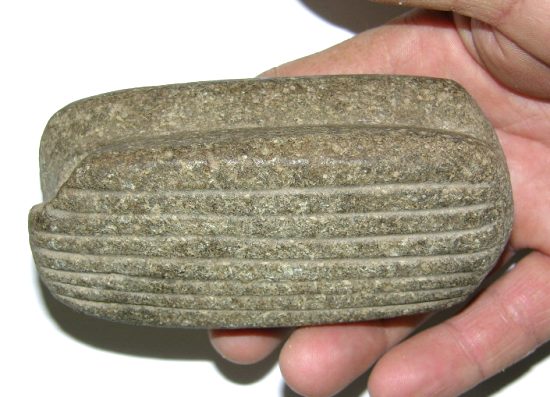Tools
Sadly, no writing implements from the Maya period have been found, but sources believe that the Maya must have had some time of quill or fine-tipped writing implement due to the varied width of lines (from wide to very thin and fine). These were probably made from sharpened, shaped bird feathers or whittled sticks. The Maya also used brushes of some kind, as evidenced by the strokes on pottery and paper, perhaps with animal hair bound to a stick or bone. Maya scribes would also have needed pots or perhaps shells to make and hold the inks that they were using.
As mentioned on the previous page, in order to make the paper, the Maya would need several tools to help create their paper. A knife or scraper made of stone (perhaps obsidian) or shell was used to help scrape the latex build-up off the inner bark pulp after it had been soaked in the running water. This would also be helpful in smoothing the fibers of the wood surface after it had been soaked, but before it was beaten to become pliable.

Stone bark beater showing ringed notch around edge and grooved side (source). The flat-surfaced side can be seen at the source link as well.
A bark beater would have been used to soften the fig bark fibers and to spread them to create a more even thickness and writing surface. (See one in action in the video on the previous page, also found on YouTube.) Bark beaters were made of stone or wood, and some had long handles. Others are flat, almost like an oblong spheroid shape, and had a groove around the center ring either to facilitate holding the implement or to allow it to be bound to a handle. From the images found online of bark beaters found in Mexico and Central America, one side of the beater was lined with grooves and the other was flat. Perhaps the grooved edge was used to help flatten and smooth the inner bark pieces before using the smooth side for a smoother, flatter writing surface. It is possible that the flat side was also used to smooth the plaster/stucco lime mixture that was used to prepare the surface of the page.
Frames of some sort would also be needed to lay the paper out for drying. The paper could be dried flat on a board, but the smoothness indicates that perhaps it was dried between two boards. This would take more time to dry, but would allow for the surface to have a more even thickness. The pages were quite long (before being folded into the accordion shape) and would need to be dried on a long plank-like surface. The paper could be trimmed to a uniform thickness with a sharp stone or knife.